Problems with cracking render
If you need help and advice with cracks in render that could be hiding structural problems or render that has fallen off the building which could be allowing dampness into the property please free phone us on 0800 298 5424 for free, friendly advice.
Building Surveyors – an introduction to render and cracking problems
We are independent surveyors who can provide help and advice. We carry out many building surveys, structural surveys, independent valuations, property surveys, structural reports, engineers reports, specific defects reports and home buyers reports.
As you will see when reading through this article we use lots of sketches and photos in our articles and reports as the feedback we have from our clients is that the sketches and photos help them to fully understand the problems and issues.
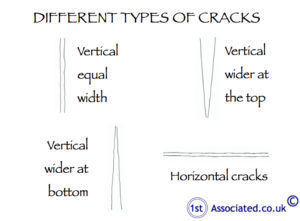
Different types of cracks
Compare our Building Surveys but don't compare Apples with Thursdays
We have a wealth of knowledge and experience as independent surveyors and we have worked on many different types and eras of property.
We fully appreciate all properties are unique therefore making all our surveys unique and tailored to your individual needs.
We are happy to email you example surveys. Please call us on Free phone 0800 298 5424.
We have every confidence in our surveys and believe there are no other comparable surveys out there in the UK property and surveying market.
Cracks
Many of our clients request a survey of a property due to cracking that they have seen in the render of their property, sometimes when they live in it but most frequently when they are about to purchase a new property such as a new house or a new business premises. Cracks are one of the key things that we are asked to look out for when carrying out a building survey or structural survey
Cracks take many different forms and sizes - remember the crack is the affect, not the cause
The cracking can take many forms and sizes from hairline cracking (see our hairline sketch to the right hand side) to wide open cracks. Some cracks are of equal width at the top and the bottom; other cracks have a V shape and are wider at the top than the bottom and cracks that are the opposite being wider at the bottom than the top.
All of these need a trained and experienced Building Surveyor to establish the reason behind the crack.

Hairline cracking
Crack is the affect – what is the cause?
You should remember whatever size the cracks are, or whatever their location they are the affect not the cause of the problem. You need to establish what the cause is so the problem can be resolved; an experienced Building Surveyor will be able to read the building and understand the cracks within it. There are many forms of cracks in properties which we see when we carry out building surveys.
Here are a few examples

Different types of cracks
Harmless cracks
Many cracks are perfectly harmless and almost could be considered a feature of the building. Equally cracks can be warning signs that there is structural movement in a property which could be in the form of settlement where the building goes down or heave where the building is lifted. It could be where parts of the building are pushing each other apart or it could be that the cracks have been hidden by the present owner and that the Building Surveyor will have to work out where there should be cracks and look very closely to spot them.
Mortgage and Panel company surveyors don't like cracks of any type
We have found that mortgage company surveyors, whether they are working as bank surveyors or building society surveyors or some other form of institutional lender simply don't like cracks. We should also mention Panel Surveyors who are another form of Bank or Building Surveyors. Unfortunately although many of them are Surveyors, they are Valuation Surveyors and therefore don't have the knowledge to understand whether the crack is a problem or not and will refer almost any crack problem onto a Building Surveyor or Building Engineer. They are often looking to have a report before they will produce a Valuation as they want to know whether the cracking will structurally affect the building and therefore affect the value particularly if it needs something like underpinning because the property is suffering from settlement, heave or subsidence and the crack is the affect.
How does a surveyor investigate problems associated with render?
We generally carry out what is known as a tap test where we tap the render which is literally hitting the render with the back of a hammer to try to establish if there are any hollow or blown areas in it. Common sense really, it is what a Surveyor deduces from this that is the important bit. A building surveyor will be able to hear whether it is hollow or blown, also known as lost its key or grip (and so would you). From this, together with their knowledge of the property as a whole and their knowledge of this type of property and location attributes they would usually be able to establish if there were problems associated with the cracks and other issues in the property.
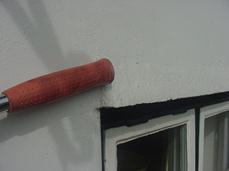
Tap testing (we recently heard it
called a rap test) to establish if
there are defective areas of render
Blown render – what a strange term
The term blown is used where the render is no longer sticking to the walls. There are also other terms for it such as losing its key. We, as much as possible, avoid technical terms. Where we do use them, we offer a definition.
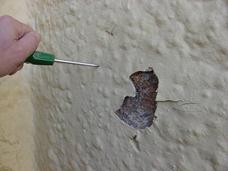
Blown area of render which has just
been painted over
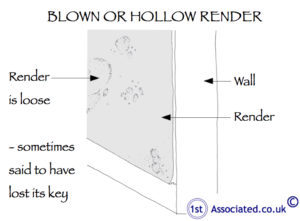
Blown or Hollow Render
Plain English building surveys and Building Definitions
Here is an example of how we would present a report to someone who has very little property knowledge when we use the term render, we would have a definition.
Render Defined
A sand and cement external coating applied in two or three coats or layers.
This, of course, would depend upon the age of the building, the type of building and the type of render.
Defects in render
We have spoken briefly above about blown render but there are lots of defects in render that the term blown render covers. This could be anything from hollow areas caused by dampness getting underneath the render or deteriorating older render which is literally falling off the walls. Render certainly has a limited lifespan, particularly if it is not looked after well.
Cracks in buildings
Our building survey reports would always advise about any cracks that are seen. Often we will photograph them and record them so you know if there have been any alterations in them.
We recently went back to a property that we surveyed some six years ago to establish if the cracking had got any worse due to tree problems nearby.
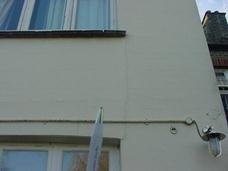
Cracking
Advice on what to do with cracks
We will usually make recommendations with regards to what to do with the cracks. There are so many myths around with regard to building and what is good building practice. Our general advice would be where cracks are visible you should always seal them as soon as possible to stop dampness getting into the building however the way they are sealed is important. A common mistake is where cement based render is used on older properties to fill a crack as the cement is much harder than the original lime based render which is more flexible. This, itself, can cause more cracks. This is just an example of the sort of advice we can give.
What do the cracks mean?
Cracks can mean so many things depending on where they are in a structure, what type of structure it is and other things relating to the site's situation and location.

Different types of cracks
Vertical Crack
An equal width crack found at the corner of a building typically means there is pressure in the building where there is perhaps expansion or contraction from the outer wall causing a pushing movement and a vertical crack. There isn't a single reason for a vertical crack, it could also be in a building where there is a weakness between two large windows but it is not necessarily the only answer.
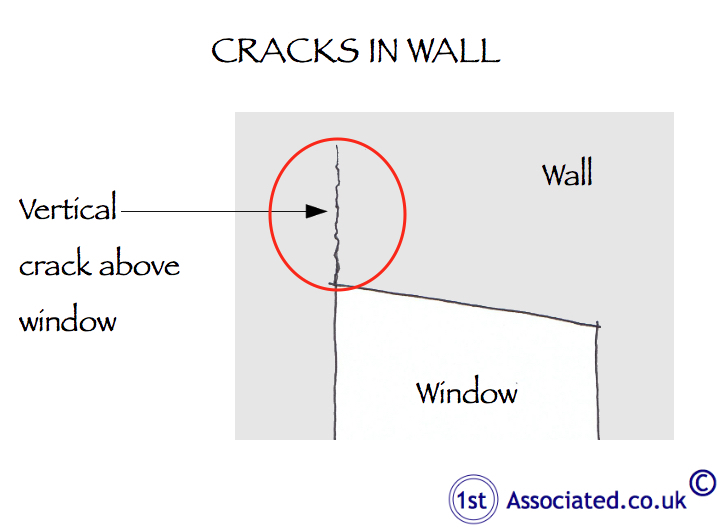
Cracks in walls
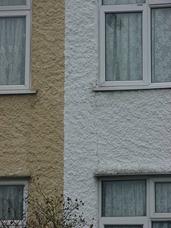
Vertical crack between
windows
Hidden cracks
Hidden crack isn't a type of crack. It is what we come across so often where a crack has been hidden by an overgrown plant, downpipe or even the owner.
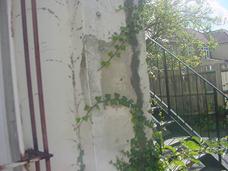
If you look carefully behind the ivy
there is a vertical crack that has
been filled in.
Horizontal Cracks
This again can be for a variety of reasons, one reason could be rusting and deterioration of wall ties that are expanding and pushing the wall structure apart horizontally. It could be settlement above a window where originally it was a timber window which has now been replaced with a plastic window that didn't quite fit but it is not necessarily the only answer.
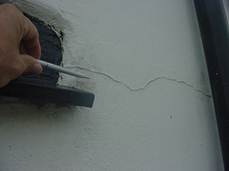
Horizontal cracking
Raking Crack
This is a diagonal crack which often relates to a problem in the ground such as the drain, nearby trees or poor foundation and this then results in settlement or heave but it is not necessarily the only answer.
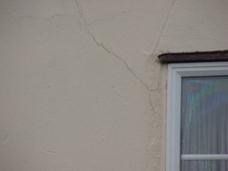
Raking hairline cracks above
the window
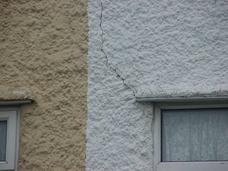
Raking crack at corner of
window
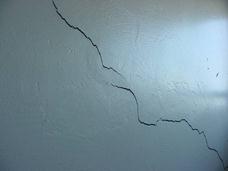
Raking crack
Hairline cracking
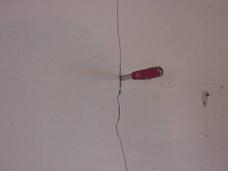
Hairline crack

Hairline cracking
Stepped Cracking
This would normally be in brickwork and does indicate that the weaker mortar has cracked rather than the bricks itself. It is when the bricks have cracked that you have a real problem usually. We are adding usually as there is no definite in surveying and it all depends upon the situation.
Floor Cracks
This example was a crack in a floor of an industrial building where the front wall was moving forward and we could see there had been repairs previously. When we looked more closely the property was on a sloping site and the building was literally trying to move down the hill.
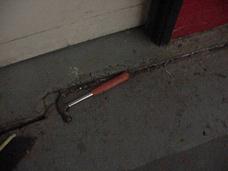
Floor cracks identified by hammer
Movement from settlement, heave or subsidence
Whatever the cause of the movement and the cracking can be anything of the above, settlement heave or subsidence. It is something that you don't want to happen to your building. If you are buying a property and then have to spend the next six months to a year when it is being underpinned it will obviously be a major problem. In addition to this we would say that when a property has been underpinned it simply doesn't have the same value as a property that hasn't been underpinned.
Underpinning
Most people would be put off purchasing a property where underpinning has taken place however we would comment that underpinning is a popular way of resolving problems in clay areas particularly where there are trees and/or underground water in the area. You need to ensure that you are happy to buy a property with this characteristic and that when you come to sell it may affect the value.
We personally do not recommend large amounts of underpinning on older properties, which was common in years gone by, as the extra weight can cause equal stress and strain on the property and ironically cause further problems.
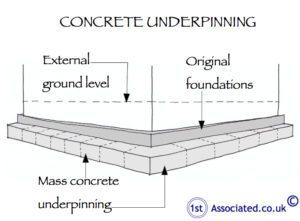
Concrete underpinning
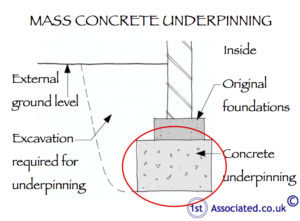
Mass concrete underpinning
Underpinning – Your Legal Advisor should check
Prior to purchasing a property which has been underpinned we would recommend your legal advisor checks what information is available in relation to the underpinning and again we would reiterate that cracking and underpinning usually affects the value of the property.
This has been the briefest look at cracking and cracking that you can see in render. We hope this helps, we would be more than happy to talk to anyone who wants further information on free phone 0800 298 5424.
Different types of render
Before we finish this article we just wanted to comment on different types of render as they can be repaired in different ways. They also have different features, for example a smooth render will need good detailing around the windows i.e. a drip detail around the window and a bell mouth at the base whereas a pebbledash render or a stippled render tends to discharge water in a different way and also hides hairline cracks very well. Therefore you have to look very carefully as a Building Surveyor to see if there are problems within a pebbledash rendered wall that is unless someone is trying to repair them when they usually manage to match the original mortar. We know a tradesman's trick for matching the original render but will keep quiet about this as it makes a surveyor's job a lot easier when the render repair that is hiding the movement crack is a slightly different colour.
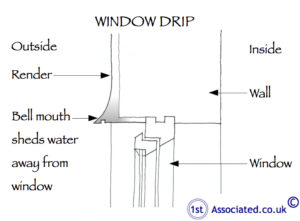
Window drip
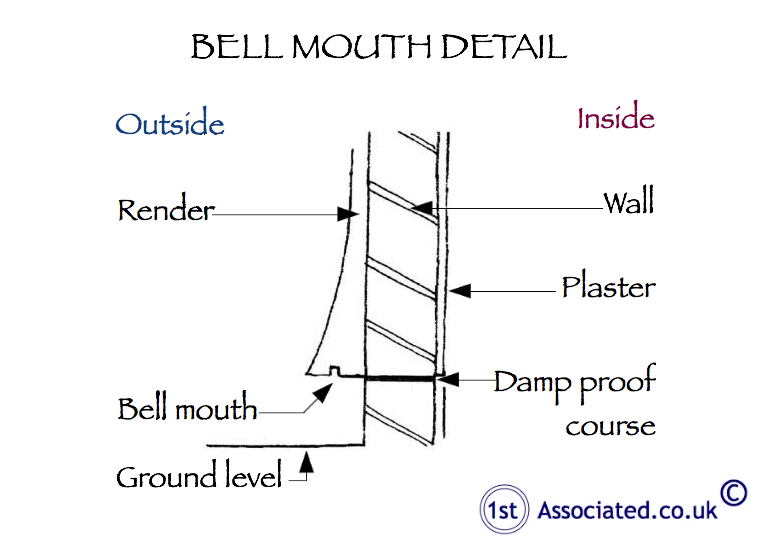
Bell mouth

Smooth render
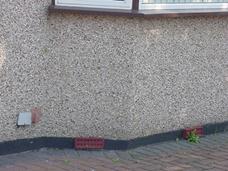
Pebbledash render
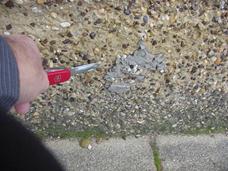
Difficult to match in to
pebbledash render
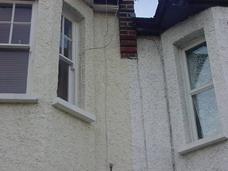
Stippled render
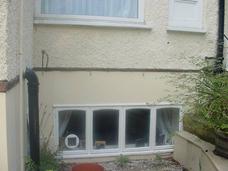
Stippled render next to
smooth render
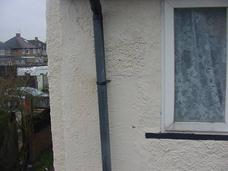
Repairs to old render
What do the ovals and circles mean in our building survey reports?
You will find within our reports that some photos and sketches have circles or ovals on them like this example to the right. The circles and ovals are a system that we use within our structural surveys and building surveys to highlight problem areas (such as cracking) so that you are not left wondering what the problem is.
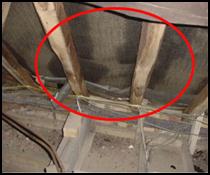
An example of one of our photos
Our articles
We hope you found the article of use and if you have any experiences that you feel should be added to this article that would benefit others, or you feel that some of the information that we have put is wrong then please do not hesitate to contact us (we are only human).
The contents of the web site are for general information only and are not intended to be relied upon for specific or general decisions. Appropriate independent professional advice should be paid for before making such a decision.
Commercial Property
If you are looking for commercial property, whether it is freehold or leasehold, we would recommend a survey as this will prevent dilapidations claims in the long run. You may wish to look at our Dilapidations Website at www.DilapsHelp.com and for Disputes go to our Disputes Help site www.DisputesHelp.com , both of which we have been advised are very helpful!
All Rights reserved
All rights are reserved the contents of the website are not to be reproduced or transmitted in any form in whole or part without the express written permission of www.1stAssociated.co.uk

